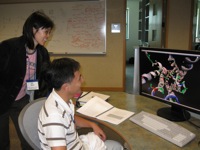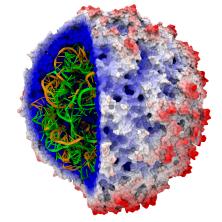Report on the 2008 / 2009 Academic Year
The Theoretical and Computational Biophysics Group (TCBG) has been exemplary in number of publications of the five associated faculty in 2008 and 2009, namely 108. The citation numbers for VMD (1500), NAMD (800) and, for example, other Schulten papers (4000) citations during those years are equally impressive, reflecting a strength in both software (VMD, NAMD) development and biomedical research. In 2009, VMD saw a new release (1.8.7); NAMD is scheduled for a new release (2.7) in November of this year; three training workshops were held in 2009, the web site received 110,000 visitors downloading 340 GByte of data, both numbers referring to averages per month.

A key development in 2009 was a complete remodeling of the TCBG space resulting in a beautiful highly functional public area used for high end visitor workstations, for group and visitor discussion spaces, for a yet to be completed stereo projection system serving an audience of up to 40, and for other functions (here). The new space is optimal for training purposes and serves frequent visitors to TCBG. Altogether, the "vital readings" of TCBG are excellent, offering a strong basis for advancing further the link of the TCBG to the research community and for continuing strong development and research at TCBG.
The year 2008-2009 publications of TCBG cover subject areas in the following order: theory and computational methodology (30%), membrane processes (30%), large size systems (15%), nanotechnology (10%), long time simulations (10%), quantum biology (10%), molecular medicine (8%), and cell mechanics (8%), percentages adding up to over 100 % due to overlapping subject areas. Overall, the subject areas are well focused, suitable for TCBG's methodological orientation and for collaborative projects requiring extreme computing.
Both VMD and NAMD have added an impressive and useful number of features. In particular, both programs support in their 2009 releases graphics processing unit (GPU) acceleration with partially impressive results (see here), but with further development needs in other cases. TCBG is part of an NVIDIA (leading graphics chip manufacturer) Center of Excellence that supports TCBG funding-wise and through access to the latest software tools and graphics boards.
User numbers have further skyrocketed, counting over 30,000 NAMD and over 120,000 VMD registered users.

TCBG continues to be active in many collaborative projects that involve mainly experimental laboratories. From these collaborations resulted in 2008-2009 53 joint publications. Presently, TCBG is involved in 37 active collaborations that fit very well the mold of TCBG in being based on recent or new advances in computational technology, in theory, or in analysis methods. The features of the new VMD and NAMD releases are a direct outcome of these collaborations. Key opportunities for collaborations have arisen from the new (started September 2008) National Science Foundation-funded Center for the Physics of Living Cells (CPLC), co-directed by Dr. Schulten. Present CPLC-TCBG experimental-computational collaborations involve ribosome dynamics (here), helicase mechanism (here), motor protein function, and whole cell transcription. CPLC organized jointly with TCBG faculty a summer workshop with participants from world-leading institutions.
The stated collaborations lead to scientific breakthroughs made possible through accelerating molecular dynamics methodology (combining single molecule experiments and modeling, on elucidating mechanical protein structure and function for the muscle protein titin (here), describing protein folding in atomic detail (here), and assisting H1N1 flu drug development), through coarse graining (here) and GPU acceleration methodology (cell morphogenesis, electrostatics, and free energy calculation), through large scale molecular dynamics (structure determination for ribosome elongation cycle intermediates, for the molding of photosynthetic organelles in purple bacteria, and for whole cell modeling), and through mixed methodologies (nanopore sensor development and quantum biology of vision, of photosynthesis, and of magnetoreception in animals). Clearly the balance of research and development adds to the unique success of this Resource.
The aims of TCBG in the next academic year are:
- Continue advancing computational methods.
- Increase simulation size and develop molecular systems concepts.
- Increase simulation time and identify respective relevant research topics.
- Consider broadening of the "nanotechnology" focus to "special systems", e.g., include RNA.
- Link classical and quantum modeling.
- Continue the special focus on membrane and mechanical processes.
- Branch out to molecular medicine, e.g., extend the present H1N1 flu resistance study.
TCBG infrastructure on software will be developed along the following lines:
- Create an ongoing software workshop for staff, students, collaborators, and visitors for millisecond molecular dynamics, quantum chemistry-based molecular dynamics, efficient integration of new force fields, GPU acceleration, and enhancing the molecular dynamics flexible fitting method.
- Integrate computational biology further into experimental biology, in particular, for single molecule studies, large structure determination, and cellular tomography.
- Strengthen further training and teaching through electronic material (lectures, tutorials, case studies in textbook format) for high performance computing researchers and for general researchers, in particular, experimentalists.

Likewise, TCBG hardware infrastructure (here) will be developed along the following lines:
- Prepare computational biology for efficient use of upcoming petascale machines.
- Prepare computational biology for efficient use of upcoming GPU clusters.
- Work with national centers on computer platforms optimal for quantum-classical mechanics.
- Build a specialized millisecond simulation platform.
- Develop a hardware platform for largely automated setting-up of simulations.
- Develop a platform for the analysis of extreme data intensive simulations.
TCBG made already impressive advances in regard to developing a next generation software and hardware infrastructure. Through its vicinity in Urbana to the $366 million National Center for Supercomputing Applications Blue Waters Project TCBG is in an excellent position to be a bridge between new generation platforms and software on the one side and the most advanced biomedical research and general bench scientist on the other side.
Criteria for a successful work at TCBG will be:
- Is fundamental science being advanced?
- Is the best technology furnished?
- Are solutions provided being integrated for ease of use?
- Is a close link to the biomedical community established?
The recent work of TCBG measures up to these criteria:
- The TCBG effort in extension of time and size scales of NAMD simulations promises great research opportunities in the near and far future.
- The TCBG effort preparing NAMD and VMD for Petascale and GPU computing is extremely timely and promising.
- The close integration of NAMD and VMD is bearing excellent fruits and provide a unique position of TCBG's software in Computational Biology today.
- Strong serve as reflected in user numbers and web site development provide a strong base for continued relevance of the work at TCBG.
- Cell morphology research, i.e., the study of proteins shaping cellular membranes, is a new, highly promising avenue for TCBG's entry into cell biology.
- Likewise, nanotechnology device development is a future-oriented activity that will only increase in importance and place TCBG in a uniquely strong position.
- Research responsiveness, as illustrated most recently by TCBG's quick adoption of H1N1 flu simulations on the looming danger of drug resistance (here), and described concisely through TCBG's monthly research highlights, is impressive.
- TCBG continued to develop basic computational methods like new analysis tools in VMD, the molecular dynamics flexible fitting (MDFF) method, and the adoption of new force fields into NAMD (the latter still ongoing).
- VMD proves indispensable to the biomedical research community; NAMD remains widely used.
- TCBG is engaged in a uniquely strong training effort with two hands-on workshops (here, here) and a key role in the Center of the Physics of Living Cells summer workshop (here), all in the summer of 2009.
Altogether, the Theoretical and Computational Biophysics Group, now in its 20th year, remains young, strong, and visionary.



